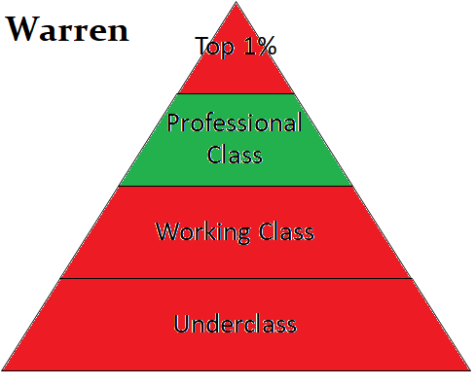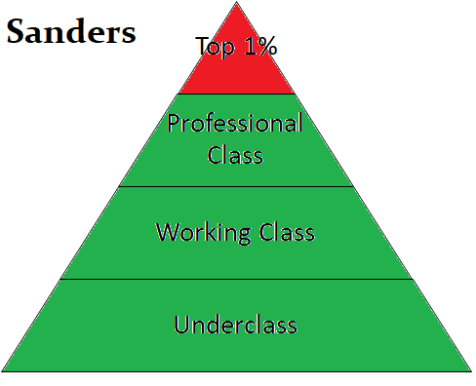The Main Difference Between Warren and Sanders
by Benjamin Studebaker
In the second round of Democratic primary debates, Elizabeth Warren and Bernie Sanders were in the same room, but the two of them were surrounded by centrist Democrats who poll at almost nothing. Stephen Bullock, John Delaney, John Hickenlooper, Amy Klobuchar, and Tim Ryan all clock in at 1% or less. Together, they spoke for more than 50 minutes, and they used most of their time to insinuate that policies like Medicare are a socialist pipe-dream. Sanders and Warren each received about 18 minutes, combining for about 36. By including all these centrists that poll at negligible numbers in the debates, the Democratic Party drowned the progressive candidates in a cacophony of establishment hand-wringing. There was never an opportunity for Sanders and Warren to argue with each other, and now many in the media are portraying Sanders and Warren as if they were on a progressive “team”. This obfuscates the very real differences between these candidates, so let me do the job that the Democratic Party and the moderators failed to do, and illustrate those differences for you.
Sanders and Warren both criticise the Democratic Party establishment, but from very different directions. Think about America in terms of four classes:
- The millionaire and billionaire class, which includes the people in the top 1%, who make more than $300,000 per year.
- The professional class, which includes the people in the top 25% (with incomes between $70,000 and $300,000)
- The working class, which includes the people between the 25th percentile and the 75th percentile (with incomes between $20,000 and $70,000)
- The underclass, which includes the people in the bottom 25% (with incomes below $20,000).
In the old days, when Franklin Roosevelt and Lyndon Johnson were creating and expanding Medicaid, food stamps, the minimum wage, and other programs meant to help even the poorest and most vulnerable Americans, the Democratic Party was trying, on some level, to help Americans in all four classes.
Gradually, this changed. Following the 1968 election, many professional class Democrats wanted the party to oppose the Vietnam War and support civil rights in a more muscular way. But many unions were resistant to this. Americans in the working class and underclass were more socially conservative and more hawkish on foreign policy. The professionals solved the problem by creating the modern primary system. It had several effects:
- By forcing candidates to campaign in both primaries and general elections, it made campaigns longer and more expensive, increasing the power of moneyed interests within the party.
- Professional class voters are far more likely to turn out for primaries than working class and underclass voters, giving them far more influence in those primaries.
- The union bosses–who previously had substantial influence in local and regional party machines–lost this influence, and they were offered nothing to replace it.
These reforms cumulatively increased the power of the professional class within the party at the expense of the working class and the underclass. As the historian Byron Shafer puts it:
The period from 1968 to 1972 saw the rise of an alternative coalition of Democratic elites, different in social background, political experience, and political preference from the coalition that has previously dominated the national Democratic party…These differences could be summarized with the observation that the old coalition was based in blue-collar constituencies, while the newer version was white-collar from top to bottom.
This is visible in top 1% income shares, which began rising under Jimmy Carter and increased substantially under Bill Clinton and Barack Obama:

The Democrats cut the working class and the underclass loose, with devastating electoral impact. In the 40 years before 1968, the Democrats won 70% of the presidential elections and controlled the senate 80% of the time. In the 40 years after 1972, the Democrats won 50% of the presidential elections and controlled the senate just 55% of the time. When the Democrats controlled the senate, their majorities were smaller. They possessed super-majorities from 1933 to 1943, and again from 1963 to 1969. At times these majorities were gargantuan–in six separate congresses, the Democrats won more than 65 seats. But after 1969, the Democrats never again exceeded 61.
As the working class and underclass were pushed out of the Democratic Party, “Rockefeller Republicans” moved in. These Republicans were the socially liberal but fiscally conservative supporters of Nelson Rockefeller, the billionaire who tried and failed to win the Republican nomination in 1968. Hillary Clinton was among them. Joe Biden was first elected to the senate in 1972, under the new reforms. This wasn’t enough for Elizabeth Warren. She remained a Republican until 1996, and voted for Ford, Reagan, and the first President Bush. When she became a Democrat and began touring her book, The Two Income Trap, Warren did not emphasize the working class and underclass voters the party left behind. Instead, she made the case that it was the professional class itself which was being neglected. She said:
Most people define “middle class” by income. And by income, I will be the first to confess a large proportion of the families in bankruptcy look like they’re poor or at the ragged edge of the working class, middle class. But income alone doesn’t really define class. You know, if a fourth grade teacher lost her job and was out of work for a year, would you describe her as not middle class anymore? If a bank president lost his job, would you describe him as not middle class anymore? If we look at the enduring criteria–education, occupation, having bought a home–it turns out the population in bankruptcy is disproportionately middle class. So if we take anyone who went to college as, that’s some indication of being middle class, anyone who has an occupation in the upper 80% of occupations in the United States–that is cutting out day laborers, housemaids, and the lower status jobs–or anyone who actually went out and bought a home, as middle class, our population in bankruptcy is more than 90% middle class. In other words, when we look at the families that are filing for bankruptcy, it’s not the very poorest and of course it’s not the very richest. We under-represent brain surgeons and college professors…We’re really talking about people who are way down on the income side, but who, in terms of their own aspirations, class status, vision of themselves, are solidly middle class people.
The three criteria Warren uses are all very different. The “top 80%” of occupations, would exclude the underclass, but include the working class. The “homeowners” would include roughly 65% of Americans, cutting out a significant portion of the working class. The “college educated” would include just 33%, excluding the bulk of the working class. When Warren references specific individuals, she talks mainly about bankers, surgeons, and professors–these are all people in the professional class, in the top quarter. She emphasises people who are “aspirational”, who are trying to gain social status.
This links up with the language both Democrats and Republicans increasingly use to exclude the working class and underclass from political life. First, they drew a distinction between the “deserving poor” and “undeserving poor”–between the people in the underclass who were trying to leave the underclass and the people in the underclass who were content to remain there. Then they began drawing this distinction between “aspirational” people–who go to college and try to secure white-collar, professional class jobs–from those who are content to remain blue-collar. In this way, increasingly large percentages of the working class are lumped in with the underclass as “undeserving”. Only those who are trying to move up, who are trying to become professionals, are considered worthy of help or concern.
This is echoed in Warren’s policies. Warren tries very hard to exclude people she considers unworthy from her proposals. Sanders works in universals, claiming that Americans ought to have rights as citizens to healthcare and to education. But Warren doesn’t have a Medicare-For-All plan on her website. While she offers to cancel some student debt, she restricts the amount that can be cancelled. While she offers to support tuition-free college, she supports it only in those states which are willing to contribute their own funds to the program, creating a two-tier system between “deserving” blue states and the “undeserving” red. Her “universal” childcare policy doesn’t create a universal right to childcare–it charges families for the service. Warren means-tests everything and she is always reluctant to create new economic rights.
For Sanders, the problem is that the Democratic Party has neglected the working class and the underclass. For Warren, the problem is that the professional class is itself under threat from the rich. Both are rebelling against the party establishment, but in entirely different ways. Here, let me put it in charts for you…
The Democratic Party establishment now attempts to balance the interests of its wealthy donors against the interests of the professional class, ignoring the working class and the underclass completely:
Elizabeth Warren is mad at the top 1%, but only because the top 1% is increasingly making it difficult for people to reach the professional class and remain there:
Sanders is the only one who is actually trying to re-integrate the working class and underclass into political life. This is the essence of his “political revolution”–it is about mobilizing the people who have been abandoned to the Republican Party or isolated from politics altogether:
Sanders and Warren look like they’re on the same side when they are attacking the top 1% or when they are defending the interests of college-educated professionals. But who is the one who pledges to guarantee a job to any American who wants one, regardless of education or status? Who is the one who has personally pressured firms like Amazon into raising wages for rank and file workers? Who is the one who personally emphasizes the plight of striking McDonald’s workers–most of whom don’t have college degrees and may never pursue them? Who is the one who uses his campaign apparatus to encourage more people to support them? Sanders:
Warren believes in a meritocratic system, where the deserving members of the working class and underclass can work hard and earn their way into the professional class. Sanders believes that all our citizens, regardless of class position, ought to be entitled to a decent life. That’s the difference. That’s why Warren declined to endorse Sanders in 2016. That’s why Warren says she would have accepted an offer to become Hillary Clinton’s Vice President. That’s why Warren still says she’s “capitalist to her bones”. That’s why Warren clapped for Trump when the president said there would never be socialism in this country:
There is a real difference here, and we should talk about it. But as long as the Democratic debates are conducted by television media behemoths and filled to the brim with stand-ins for Joe Biden, we won’t get the chance. Sanders and Warren should hold their own debate, separate from the party spectacle, moderated by capable people who aren’t on the payroll of NBC or CNN.


